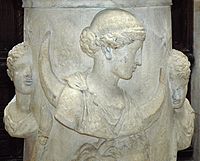Selene
| Greek deities series |
|---|
| Titans |

In Greek mythology, Selene (Σελήνη, "moon"; English /sɛˈliːniː/) was an archaic lunar deity and the daughter of the titans Hyperion and Theia.[1] In Roman mythology, the moon goddess is called Luna, Latin for "moon".
Like most moon deities, Selene plays a fairly large role in her pantheon, which preceded the Olympic pantheon. However, Selene was eventually largely supplanted by Artemis, and Luna by Diana. In the collection known as the Homeric hymns, there is a Hymn to Selene (xxxii), paired with the hymn to Helios; in it, Selene is addressed as "far-winged", an epithet ordinarily applied to birds. Selene is mentioned in Nonnus, Dionysiaca 48.581; Pausanias 5.1.4; and Strabo 14.1.6,
The etymology of Selene is uncertain, but if the word is of Greek origin, it is likely connected to the word selas, meaning "light".[2] Boreion Selas is the Greek name for Aurora Borealis. In modern times, Selene is the root of selenology, the study of the geology of the Moon, and the chemical element selenium.
Depictions
In post-Renaissance art, Selene is generally depicted as a beautiful woman with a pale face, riding a silver chariot pulled by a yoke of oxen or a pair of horses. Often, she has been shown riding a horse or bull, wearing robes and a half-moon on her head and carrying a torch. Essentially, Selene is the moon goddess but is literally defined as 'the moon'.
Myths

Genealogy
In the traditional pre-Olympian divine genealogy, Helios, the sun, is Selene's brother: after Helios finishes his journey across the sky, Selene, freshly washed in the waters of Earth-circling Ocean,[3] begins her own journey as night falls upon the earth, which becomes lit from the radiance of her immortal head and golden crown[3]. When she is increasing after mid-month, it is a "sure token and a sign to mortal men". Her sister, Eos, is goddess of the dawn. Eos also carried off a human lover, Cephalus,[4] which mirrors a myth of Selene and Endymion.
As a result of Selene being conflated with Artemis, later writers sometimes referred to Selene as a daughter of Zeus, like Artemis, or of Pallas the Titan. In the Homeric Hymn to Hermes, with its characteristically insistent patrilineality, she is "bright Selene, daughter of the lord Pallas, Megamedes' son."

Lovers
Apollonius of Rhodes (4.57ff) refers to Selene, "daughter of Titan", who "madly" loved a mortal, the handsome hunter or shepherd—or, in the version Pausanias knew, a king— of Elis, named Endymion, from Asia Minor. In other Greek references to the myth, he was so handsome that Selene asked Zeus to grant him eternal sleep so that he would stay forever young and thus would never leave her: her asking permission of Zeus reveals itself as an Olympian transformation of an older myth: Cicero (Tusculanae Disputationes) recognized that the moon goddess had acted autonomously. Alternatively, Endymion made the decision to live forever in sleep. Every night, Selene slipped down behind Mount Latmus near Miletus.[5]
Selene had fifty daughters, the Menae, by Endymion, including Naxos, the nymph of Naxos Island. The sanctuary of Endymion at Heracleia under Latmus on the southern slope of Latmus still exists as a horseshoe-shaped chamber with an entrance hall and pillared forecourt.
Though the story of Endymion is the best-known one today, the Homeric hymn to Selene (xxxii) tells that Selene also bore to Zeus a daughter, Pandia, the "utterly shining" full moon. According to some sources, the Nemean Lion was her offspring as well. According to Virgil[6] she also had a brief tryst with Pan, who seduced her by wrapping himself in a sheepskin[2] and gave her the yoke of white oxen that drew the chariot in which she is represented in sculptured reliefs, with her windblown veil above her head like the arching canopy of sky. In the Homeric hymn, her chariot is drawn by long-maned horses.
Luna
The Roman moon goddess, Luna, had a temple on the Aventine Hill. It was built in the sixth century BC, but was destroyed in the Great Fire of Rome during Nero's reign. There was also a temple dedicated to Luna Noctiluca ("Luna that shines by night") on the Palatine Hill. There were festivals in honor of Luna on March 31, August 24 and August 29.[7][8]
Modern use
"Selena" ranked 815th and "Selene" 2555th in a common US-based listing of Most Popular Female First Names" [9]
Notes
- ^ Bibliotheke of Pseudo-Apollodorus, 1.2.2; Hesiod gives a list of the offspring of Hyperion and Theia in Theogony, lines 371ff. In the Homeric Hymn to Helios, Theia is given the name Euryphaessa, the "far-shining" one, an epithet that would apply to Selene herself.
- ^ a b Kerenyi, Karl (1951) The Gods of the Greeks (pp. 19, 197). 1951.
- ^ a b Homeric Hymn.
- ^ Burkert, Walter (1985). Greek Religion (p. 176).
- ^ Apollonius, loc. cit.; Pausanias v.1.5.
- ^ Virgil, Georgics, iii.391.
- ^ Grimal, Pierre (1986). The Dictionary of Classical Mythology (p. 262). Oxford: Basil Blackwell. ISBN 0-631-20102-5.
- ^ Hammond, N.G.L. & Scullard, H.H. (Eds.) (1970). The Oxford Classical Dictionary (p. 625). Oxford: Oxford University Press. ISBN 0-19-869117-3.
- ^ Female names.
External links
- Theoi.com: Selene Passages from Greek texts, in translation
